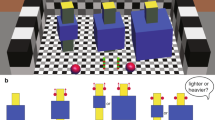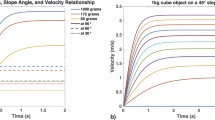Abstract
The review is dedicated to the role of gravity in the implementation of human cognitive functions. The weightlessness on various aspects of cognitive activity is considered, such as the choice of a vertical, the formation of a reference system, including the time coordinate, the recognition influence of the symmetry of complex shapes, the processes of memorizing and recognizing images, and orientation in three-dimensional labyrinths. It is described how the EEG activity of the brain in response to visual stimuli changes in weightlessness. It is shown that in weightlessness there are not only changes in the work of reflex mechanisms, but also restructuring at the level of the cognitive system, in particular, “reprogramming” of sensorimotor systems, and the development of new skills for the functioning of the brain in changed conditions.
Similar content being viewed by others
REFERENCES
Clément, G., Gurfinkel, V.S., Lestienne, F., et al., Adaptation of postural control to weightlessness, Exp. Brain Res., 1984, vol. 57, no. 1, p. 61.
Clément, G., Gurfinkel, V.S., Lestienne, F., et al., Changes in posture during transient perturbations in microgravity, Aviat. Space Environ. Med., 1985, vol. 56, no. 7, p. 666.
Liddell, E. and Sherrington, C., Reflexes in response to stretch (myotatic reflexes), Proc. R. Soc. London, Ser. B, 1924, vol. 96, no. 675, p. 212.
Magnus, R., Körperstellung: experimentell-physiologische Untersuchungen über die Einzelnen bei der Körperstellung in Tätigkeit, Berlin: Springer-Verlag, 1924.
Gurfinkel, V.S. and Levik, Yu.S., Sensory complexes and sensorimotor integration, Fiziol. Chel., 1979, vol. 5, no. 3, p. 269.
Levik, Y.S., Motor control based on the internal representation system on the earth and in space, Hum. Physiol., 2021, vol. 47, no. 3, p. 335. https://doi.org/10.1134/S0362119721030099
Levik, Y.S., Research in space and new concepts in the physiology of movements, Aviakosm. Ekol. Med., 2020, vol. 54, no. 6, p. 80.
Clément, G., Vieville, T., Lestienne, F., and Berthoz, A., Modification of gain asymmetry and beating field of vertical optokinetic after-nystagmus in microgravity, Neurosci. Lett., 1986, vol. 63, no. 3, p. 271.
Thornton, W.E., Uri, J.J., Moore, T., and Pool, S., Studies of the horizontal vestibulo-ocular reflex in spaceflight, Arch. Otolaryngol. Head Neck Surg., 1989, vol. 115, no. 8, p. 943.
André-Deshays, C., Israël, I., Charade, O., et al., Gaze control in microgravity: 1. Saccades, pursuit, eye-head coordination, J. Vestibular Res., 1993, vol. 3, no. 3, p. 331.
Israël, I., André-Deshays, C., Charade, O., et al., Gaze control in microgravity: 2. Sequences of saccades toward memorized visual targets, J. Vestibular Res., 1993, vol. 3, no. 3, p. 345.
Clément, G., Popov, K.E., and Berthoz, A., Effect of prolong weightlessness on horizontal and vertical optokinetic nystagmus in microgravity, Exp. Brain Res., 1993, vol. 94, no. 3, p. 456.
Gurfinkel, V.S., Lestienne, F., Levik, Yu.S., and Popov, K.E., Egocentric references and human spatial orientation in microgravity: I. Perception of complex tactile stimuli, Exp. Brain Res., 1993, vol. 95, no. 2, p. 339.
Gurfinkel, V.S., Levik, Yu.S., Popov, K.E., et al., Egocentric references and human spatial orientation in microgravity: II. Body-centered coordinates in the task of drawing ellipses with prescribed orientation, Exp. Brain Res., 1993, vol. 95, no. 2, p. 343.
Papaxanthis, C., Pozzo, T., Popov, K.E., and McIntyre, J., Hand trajectories of vertical arm movement in one-G environments, Exp. Brain Res., 1998, vol. 120, no. 4, p. 496.
Lipshits, M.I., Gurfinkel’, E.V., Matsakis, I., and Lestienne, F., Influence of weightlessness on sensorimotor interaction during operator activity: proprioceptive feedbacks, Aviakosm. Ekol. Med., 1993, vol. 27, no. 1, p. 26.
Lipshits, M.I., Makintair, D., and Polyakov, A.V., The influence of weightlessness on the reproduction of a particular position in various operating modes of the handle, in Problemy neirokibernetiki (Problems of Neurocybernetics), Rostov-on-Don, 1999, p. 96.
Lipshits, M.I., Gurfinkel’, E.V., Matsakis, I., and Lestienne, F., Influence of weightlessness on sensorimotor interaction during operator activity: visual feedback and latent time of motor response, Aviakosm. Ekol. Med., 1993, vol. 27, no. 1, p. 22.
Lipshits, M. and McIntyre, J., Haptic perception in weightlessness: a sense of force or effort? Proceedings of 12th Man in Space Symposium, June 8–13, 1997, Abstracts of Papers, Washington DC, 1997, p. 36.
Popov, K.E., Roll’, R., Lipshits, M.I., et al., Errors in targeted hand movements during orbital flight, Aviakosm. Ekol. Med., 1999, vol. 33, no. 2, p. 3.
Semjen, A., Leone, G., and Lipshits, M., Motor timing under microgravity, Acta Astronaut., 1998, vol. 42, nos. 1—8, p. 303.
Semjen, A., Leone, G., and Lipshits, M., Temporal control and motor control: two functional modules which may be influenced differentially during microgravity, Hum. Mov. Sci., 1998, vol. 17, no. 1, p. 77.
Leone, G., Lipshits, M., McIntyre, J., and Gurfinkel, V., Independence of bilateral symmetry detection from a gravitational reference frame, Spat. Vision, 1995, vol. 9, no. 1, p. 127.
Leone, G., De Schonen, S., and Lipshits, M., Prolonged weightlessness, reference frame and visual symmetry detection, Acta Astronaut., 1998, vol. 42, nos. 1—8, p. 281.
De Schonen, S., Leone, G., and Lipshits, M., The face inversion effect in microgravity: is gravity used as a spatial reference for complex object? Acta Astronaut., 1998, vol. 42, nos. 1—8, p. 287.
Manzey, J., Lorenz, B., and Polyakov, V., Human performance during a 14 months space mission, 12th Man in Space Symposium. June 8–13, 1997, Abstract volume, Washington, 1997, p. 130.
Leone, G., Lipshits, M., Gurfinkel, V., and Berthoz, A., Is there an effect of weightlessness on mental rotation of three-dimentional objects? Cognit. Brain Res., 1995, vol. 2, no. 4, p. 255.
Lipshits, M.I., Leone, G., Gurfinkel’, V.S., and Berthoz, A., The influence of weightlessness on the inertia of mental tracking of moving objects, Aviakosm. Ekol. Med., 1995, vol. 29, no. 5, p. 20.
Lipshits, M., McIntyre, J., Zaoui, M., et al., Does gravity play an essential role in the asymmetrical visual perception of vertical and horizontal line length? Acta Astronaut., 2001, vol. 49, nos. 3—10, p. 123.
Lipshits, M. and McIntyre, J., Gravity affects the preferred vertical and horizontal in visual perception of orientation, NeuroReport, 1999, vol. 10, no. 5, p. 1085.
Lipshits, M., Bengoetxea, A., Cheron, G., and McIntyre, J., Two reference frames for visual perception in two gravity conditions, Perception, 2005, vol. 34, no. 5, p. 545.
Lipshits, M. and McIntyre, J., Role of gravitation in solving a haptic comparison problem, Hum. Physiol., 2007, vol. 33, no. 1, p. 120. https://doi.org/10.1134/S0362119707010197
McIntyre, J., Lipshits, M., Gurfinkel, V., and Berthoz, A., Internal reference frame for visual-haptic coordination, Eur. J. Neurosci., 2000, vol. 12, suppl. 11, p. 151.
McIntyre, J. and Lipshits, M., Central processes amplify and transform anisotropies of the visual system in a test of visual-haptic coordination, J. Neurosci., 2008, vol. 28, no. 5, p. 1246.
Tolman, E.C., Cognitive maps in rat and man, Psychol. Rev., 1948, vol. 55, no. 4, p. 189.
Vidal, M., McIntyre, J., Berthoz, A., and Lipshits, M., Gravity and spatial orientation in virtual 3d-mazes, J. Vestibular Res., 2003, vol. 13, nos. 4—6, p. 273.
De Saedeleer, C., Vidal, M., Lipshits, M., et al., Weightlessness alters up/down asymmetries in the perception of self-motion, Exp. Brain Res., 2013, vol. 226, no. 1, p. 95.
Cohen, M.M. and Larsen, C.A., Human spatial orientation in the pitch dimension, Percep. Psychophys., 1974, vol. 16, no. 3, p. 508.
Young, L.R., Oman, C.M., and Dichgans, J.M., Influence of head orientation on visually induced pitch and roll sensation, Aviat. Space Environ. Med., 1975, vol. 46, no. 3, p. 264.
Cheron, G., Leroy, A., De Saedeleer, C., et al., Effect of gravity on human spontaneous 10-Hz electroencephalographic oscillations during the arrest reaction, Brain Res., 2006, vol. 1121, no. 1, p. 104.
Cheron, G., Leroy, A., Bengoetxea, A., et al., Les neurosciences spatiales: l’électroencéphalographie dans la navigation virtuelle, Sci. Connect., 2006, no. 10, p. 25.
Cheron, G., Leroy, A., Palmero-Soler, E., et al., Gravity influences top-down signals in visual processing, PLoS One, 2014, vol. 9, no. 1. e82371
Cebolla, A.M., Petieau, M., Palmero-Soler, E., and Cheron, G., Brain potential responses involved in decision-making in weightlessness, Sci. Rep., 2022, vol. 12, no. 1, p. 12992.
Cebolla, A.M., Petieau, M., Dan, B., et al., Cerebellar contribution to visuo-attentional alpha rhythm: insights from weightlessness, Sci. Rep., 2016, vol. 6, p. 37824.
Takács, E., Barkaszi, I., Czigler, I., et al., Persistent deterioration of visuospatial performance in spaceflight, Sci. Rep., 2021, vol. 11, no. 1, p. 9590.
Morfoisse, T., Herrera, A.G., Angelini, L., et al., Does gravity shape internal representations of space for human 3D perception? bioRxiv, 2020. https://doi.org/10.1101/2020.03.23.003061
Koller, D.P., Kasanin, V., Flynn-Evans, E.E., et al., Altered sleep spindles and slow waves during space shuttle missions, NPJ Microgravity, 2021, vol. 7, no. 1, p. 48.
Demertzi, A., Van Ombergen, A., Tomilovskaya, E., et al., Cortical reorganization in an astronaut’s brain after long-duration spaceflight, Brain Struct. Funct., 2016, vol. 221, no. 5, p. 2873.
Jillings, S., Van Ombergen, A., Tomilovskaya, E., et al., Macro- and microstructural changes in cosmonauts' brains after long-duration spaceflight, Sci. Adv., 2020, vol. 6, no. 36, p. 9488.
Hupfeld, K.E., McGregor, H.R., Lee, J.K., et al., Alzheimer’s disease neuroimaging initiative: the impact of 6 and 12 months in space on human brain structure and intracranial fluid shifts, Cereb. Cortex Commun., 2020, vol. 1, no. 1, p. tgaa023.
Van Ombergen, A., Demertzi, A., Tomilovskaya, E., et al., The effect of spaceflight and microgravity on the human brain, J. Neurol., 2017, vol. 264, suppl. 1, p. 18.
Arone, A., Ivaldi, T., Loganovsky, K., et al., The burden of space exploration on the mental health of astronauts: a narrative review, Clin. Neuropsychiatry, 2021, vol. 18, no. 5, p. 237.
Roma, P.G., Schneiderman, J.S., Schorn, J.M., et al., Assessment of spaceflight medical conditions' and treatments' potential impacts on behavioral health and performance, Life Sci. Space Res. (Amsterdam), 2021, vol. 30, p. 72.
Delle Monache, S., Indovina, I., Zago, M., et al., Watching the effects of gravity: vestibular cortex and the neural representation of “visual” gravity, Front. Integr. Neurosci., 2021, vol. 15, p. 793634.
Kohn, F.P.M. and Ritzmann, R., Gravity and neuronal adaptation, in vitro and in vivo-from neuronal cells up to neuromuscular responses: a first model, Eur. Biophys. J., 2018, vol. 47, no. 2, p. 97.
Tays, G.D., Hupfeld, K.E., McGregor, H.R., et al., The effects of long duration spaceflight on sensorimotor control and cognition, Front. Neural Circuits, 2021, vol. 15, p. 723504.
Funding
The study was carried out within the state task of the Ministry of Science and Higher Education of the Russian Federation (subject no. 0061-2019-0012).
Author information
Authors and Affiliations
Corresponding author
Ethics declarations
The authors declare the absence of an obvious and potential conflict of interest related to the publication of this article.
Rights and permissions
About this article
Cite this article
Lipshits, M.I., Levik, Y.S. Cognitive Functions of the Brain: A Review of Research in Weightlessness. Hum Physiol 49, 165–175 (2023). https://doi.org/10.1134/S0362119722700219
Received:
Revised:
Accepted:
Published:
Issue Date:
DOI: https://doi.org/10.1134/S0362119722700219




